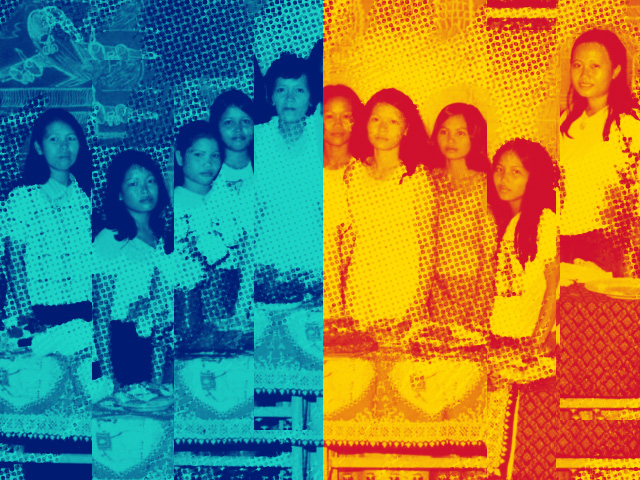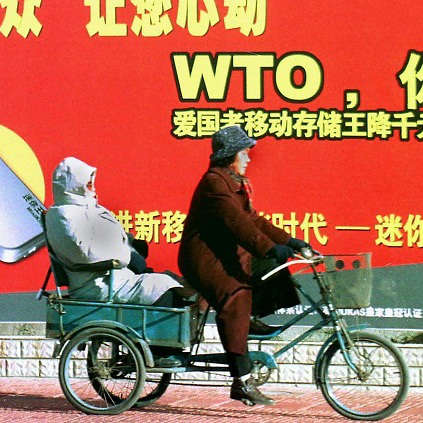Three generations of Cambodian women in my family wrestle with the inherited trauma of the Khmer Rouge

April 18, 2017
The Killing Fields (1984) was my first exposure to the war my parents survived. Just three years before the film came out, our family had arrived in the United States as refugees. We lived in a poor part of the Bronx sectioned off for Khmer refugees. One could argue that some of the issues of hygiene and safety we faced were not that different from those in the Thai refugee camps, like in Khao I Dang, where I was born.
I was a mere eight or nine years old when I saw The Killing Fields, and I had a habit of coming to my own conclusions when I wasn’t entirely sure what was going on. The first part of the film made enough sense: New York Times reporter Sydney Schanberg (played by Sam Waterston) encounters local photographer Dith Pran (played by Haing Ngor) in Phnom Penh. Even the appearance of US soldiers training Khmers was somehow normal to me. My confusion began when the Khmer Rouge forced everyone in Phnom Penh to evacuate. Why were people who looked like us doing this to one another? And the tone they took, in my parents’ language, my native tongue, was so angry and cruel. It was not an image or sound I wanted to remember, but the damage had been done. So in elementary school when we were asked to create our own books for a class project, I took what I remembered from the film and wrote something about “the war.” I drew a picture of a dead body in a lake, with blood seeping off the page. The victim had either a gunshot wound or been bludgeoned to death in the head. I was in second grade at the time. This is how my mind was able to process the image of the actor Haing Ngor walking through piles of skulls and other remains in fields where rice once grew.
My parents did not hide this film from me, but neither did they explain the causes of this Communist uprising or the estimated two million people who were killed. Many years have passed and I can’t quite remember how I phrased it, but I know I had asked some very basic questions at the time, like “What is this about?” “Why is this happening?” “Who are they?” My parents responded with simple answers: “the war in Cambodia” and “bad people.” That’s how one explains the unexplainable to an 8-year-old, right?
Years later, I would encounter these questions again when I took my own daughter along with my husband and mother to a screening of Don’t Think I’ve Forgotten (2014), a movie that profiles the thriving rock ‘n’ roll scene in Cambodia before the Khmer Rouge takeover.
My mother and I have had a rocky relationship, in part because of our cultural differences. She had a harder time shifting into the American landscape, whereas I struggled internally with both a Khmer and an American background, a tension that only intensified when I became a teenager. We didn’t talk about our struggles, our demons, anger, or sadness. Our household was usually quiet but for the sound of the TV, which played the role of reliable babysitter for my siblings and me while our parents worked multiple jobs to keep us afloat. There were random moments of confession, words my parents seemed to pull from the air, bookended by limited talk of everyday drudgery. In part I attributed those silences to a language barrier, but there was also the inherent difficulty of making sense of senseless violence. So to ask my mother to accompany us to anything this meaningful, particularly talking about a part of their lives that she and my father rarely spoke about, was a big deal.
When I was a teenager, my mother, mostly unprompted, would share snippets of her life with me. We would be listening to Khmer music on loop on our multi-disc CD player—classical wedding songs by the famous Sinn Sisamouth or Ros Serey Sothea, Khmer rock legends, or 90s synth versions of their classics—and she had associations for each of them, like the day she married my father in a weekend-long ceremony, or “Chnam Oun 16” (“I’m Sixteen”) for the nights she snuck out of the house to go dancing. There was rarely a Khmer song that she didn’t know. This was her connection. And so it became mine, through the nostalgia it evoked of a time when I didn’t exist, when my mother was a relatively free young woman. My parents’ wedding photos were destroyed during the regime so I have no images to refer to of their younger selves. This is why I fawn over old photos of my friends’ relatives, because they have versions of themselves in other decades; they can imagine themselves placed in a different period in time. At times I feel like my parents didn’t even exist in that time.
And perhaps my parents wished for nonexistence when they lost their son Sothear, the brother I never met who died from dysentery at the age of three during the regime. This became a focal point in my understanding of war as a young adult, the losses we absorb in our own family, of those we know and those we can only imagine. I try to imagine having this brother, who would have been four years older than me, alongside my younger brother, Jammy, and my older brother, Thy. How different would our childhood have been with the mayhem of an extra little boy? Or an extra mouth to feed? Or another traumatized child like Thy who ran away from home?
Most Khmer Rouge survivors have undiagnosed PTSD, and like them, my mother’s war was in the mind. Living in the Bronx in the early 1980s, she didn’t want us to open the door for anyone. We had 10 locks on our steel door, including this contraption called a police lock. Some Khmers used gambling as an escape from their depression and trauma (Khmer American filmmaker Caylee So depicts such a narrative in her short film Paulina). One night while my own father was out gambling away a paycheck, my mother remembers being terrified to leave us, but out of desperation, facing an empty pantry and a small allowance for food, she ordered my older brother to lock us in so she could run across the street to the supermarket, where she would scour the circular for deals and buy multiple bags of chips and donuts, or whatever else $10 could get her. Nutrition was not a factor; this was about survival.
To this day, I buy groceries with the same fear in mind, of starvation, of not knowing where the next meal will come from. I buy sparingly because I make food from what little is left, inspired by the miracles my mother made in the kitchen from three ingredients she would put over rice. I also still hesitate when people come to my door. Sometimes I pretend not to be home. Who might want something from me? Who might take me away? Who will question my right to be here? I don’t even feel I have the right to keep my door closed, that I’m subject to interrogation. This is how I’ve inherited my parents’ war.
Like the parents of every new generation with children, I want it to be different for my daughter. Actually, I want to stop writing about the Khmer Rouge. I want to be done—done talking about their destruction. Learning about my parents’ lives, understanding their motives, how they brought my family here, their anger at Nixon’s carpet bombing of our countryside—I was fixated on all of this for the entire decade of my 20s. I knew not to ask my parents about such details. What I wished I had gathered from them I found instead in books, documentaries, testimonies, and music of this past. I cried reading memoirs of Khmer Rouge regime survivors, replacing the faces of characters with my parents. I tried to imagine, and even then it fell short of hearing what motivated my parents to leave and how they must have felt to be on guard all the time, to starve, to lose the country they loved so much. But to continue to read about this time is to relive the war for the rest of my life, and there’s more to my parents and my home country than that.
When I took my daughter to see the rock documentary Don’t Think I’ve Forgotten she already had some inkling in her own mind of what the Khmer Rouge was. She referred to them as “pretty bad guys.” That she could rattle off that term as a reference to my parents’ historic struggle spoke to her comfort with it. But I wanted her to know more, to see this beautiful film, an homage to the musicians of Cambodia, with the dark period as a backdrop to their later demise.
Many of these Cambodian musicians were targeted by the Khmer Rouge for extermination along with other artists, ethnic Chinese, Muslims, former military members (like my father), and those with Western connections and influence. The whereabouts of Sinn Sisamouth, the most famous male vocalist of Cambodia, for example, remains unknown, although rumor has it he was made to sing a song before they shot him. Sometimes it’s the not knowing that makes these losses all the more tragic. I certainly felt that way—understanding that there was this sadness that couldn’t be explained. To this day, to hear Sinn Sisamouth’s distinct life-changing voice is to feel at once a deep love and mourning.
There is a happy ending for the film, though. For the musicians who did survive, the film’s producers and director organized a reunion concert to help revive their works, and in doing so, created a new generation of listeners, Khmer and non-Khmer alike. Our country could be known for so much more than a four-year period of darkness and death.
Meanwhile, my daughter’s first question after leaving the theater was, “Why did the U.S. bomb Cambodia?” I held off on an answer, knowing that I’d have to find some kind of satisfactory response. In the lobby of the theater we posed in front of the movie poster: my daughter, my mother, and me—three generations of women. My mother and I had sat next to each other during the film. We cried together at the old footage of an empty Phnom Penh set to the melancholy melody of an ode to the city. I held her hand. It was the first time we had ever acknowledged our joint pain, and we weren’t alone in experiencing it. So much of what we’ve each felt has been in isolation, that to admit or succumb to it in front of others would be perceived as weak, or would keep us from protecting our children. And now I understand that my mother wasn’t trying to hide the death and starvation she bore witness to, but that she simply hadn’t found a vocabulary to speak about it. She didn’t want me to obsess or be dragged down by the knowledge of her suffering and our motherland’s suffering. Instead, she would allow me the space to find my own answers when I was ready, when I had the questions.
But my daughter had this question right away. At Penn Station, as we waited to take the train among a frenzy of riders, officers with guns, and soldiers with automatic weapons, she repeated the question: “Why did the U.S. bomb Cambodia?” I couldn’t put it off now. I let out a sigh. “Well honey, I think that’s a wonderful and difficult question that you’re asking, and I think that even most adults don’t understand why that happened. I’ll try to explain it to you.” And my husband and I did our best to use modified language to help her understand. She was barely eight at the time, the same age I wrote my first “book” about war. For the next month or so, she listened to the soundtrack of the film, proudly playing it for her non-Khmer friends (which were all she had since there were few Khmers in our neighborhood). The images, bombing sounds, and music of the film would be her entry point into this Cambodian narrative. And if her first question is any indication, she will arrive at her understanding with a bit more nuance and less confusion than I did. She will be much more prepared to answer the next generation.



